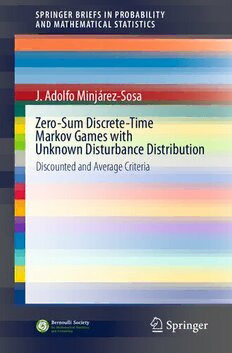Table Of ContentSPRINGER BRIEFS IN PROBABILITY
AND MATHEMATICAL STATISTICS
J. Adolfo Minjárez-Sosa
Zero-Sum Discrete-Time
Markov Games with
Unknown Disturbance Distribution
Discounted and Average Criteria
123
SpringerBriefs in Probability and Mathematical
Statistics
Editor-in-Chief
MarkPodolskij,UniversityofAarhus,AarhusC,Denmark
SeriesEditors
Nina Gantert, Technische Universita¨t Mu¨nchen, Mu¨nich, Nordrhein-Westfalen,
Germany
RichardNickl,UniversityofCambridge,Cambridge,UK
SandrinePe´che´,Univirsite´ ParisDiderot,Paris,France
GesineReinert,UniversityofOxford,Oxford,UK
MathieuRosenbaum,Universite´ PierreetMarieCurie,Paris,France
WeiBiaoWu,UniversityofChicago,Chicago,IL,USA
SpringerBriefs present concise summaries of cutting-edge research and practical
applications across a wide spectrum of fields. Featuring compact volumes of 50
to 125 pages, the series covers a range of content from professional to academic.
Briefsarecharacterized byfast,globalelectronic dissemination,standardpublish-
ing contracts, standardized manuscript preparation and formatting guidelines, and
expeditedproductionschedules.
Typicaltopicsmightinclude:
- Atimelyreportofstate-of-thearttechniques
- A bridge between new research results, as published in journal articles, and a
contextualliteraturereview
- Asnapshotofahotoremergingtopic
- Lectureofseminarnotesmakingaspecialisttopicaccessiblefornon-specialist
readers
- SpringerBriefsinProbabilityandMathematicalStatisticsshowcasetopicsofcur-
rentrelevanceinthefieldofprobabilityandmathematicalstatistics
Manuscriptspresentingnewresultsinaclassicalfield,newfield,oranemerging
topic,orbridgesbetweennewresultsandalreadypublishedworks,areencouraged.
Thisseriesisintendedformathematiciansandotherscientistswithinterestinprob-
ability and mathematical statistics. All volumes published in this series undergo a
thoroughrefereeingprocess.
TheSBPMSseriesispublishedunder theauspices oftheBernoulliSocietyfor
MathematicalStatisticsandProbability.
Moreinformationaboutthisseriesathttp://www.springer.com/series/14353
J. Adolfo Minja´rez-Sosa
Zero-Sum Discrete-Time
Markov Games with
Unknown Disturbance
Distribution
Discounted and Average Criteria
J.AdolfoMinja´rez-Sosa
DepartmentofMathematics
UniversityofSonora
Hermosillo,Sonora,Mexico
ISSN2365-4333 ISSN2365-4341 (electronic)
SpringerBriefsinProbabilityandMathematicalStatistics
ISBN978-3-030-35719-1 ISBN978-3-030-35720-7 (eBook)
https://doi.org/10.1007/978-3-030-35720-7
MathematicsSubjectClassification:91A15,90C40,62G05
©TheAuthor(s),underexclusivelicensetoSpringerNatureSwitzerlandAG2020
Thisworkissubjecttocopyright.AllrightsaresolelyandexclusivelylicensedbythePublisher,whether
thewholeorpartofthematerialisconcerned,specificallytherightsoftranslation,reprinting,reuse
ofillustrations,recitation,broadcasting,reproductiononmicrofilmsorinanyotherphysicalway,and
transmissionorinformationstorageandretrieval,electronicadaptation,computersoftware,orbysimilar
ordissimilarmethodologynowknownorhereafterdeveloped.
Theuseofgeneraldescriptivenames,registerednames,trademarks,servicemarks,etc.inthispublication
doesnotimply,evenintheabsenceofaspecificstatement,thatsuchnamesareexemptfromtherelevant
protectivelawsandregulationsandthereforefreeforgeneraluse.
Thepublisher,theauthors,andtheeditorsaresafetoassumethattheadviceandinformationinthisbook
arebelievedtobetrueandaccurateatthedateofpublication.Neitherthepublishernortheauthorsor
theeditorsgiveawarranty,expressedorimplied,withrespecttothematerialcontainedhereinorforany
errorsoromissionsthatmayhavebeenmade.Thepublisherremainsneutralwithregardtojurisdictional
claimsinpublishedmapsandinstitutionalaffiliations.
ThisSpringerimprintispublishedbytheregisteredcompanySpringerNatureSwitzerlandAG.
Theregisteredcompanyaddressis:Gewerbestrasse11,6330Cham,Switzerland
Tomytwowomen:FranciscaandCamila
Preface
Discrete-timezero-sumMarkovgamesconstituteaclassofstochasticgamesintro-
duced by Shapley in [65] whose evolution over time can be described as follows.
Ateachstage,players1and2observethecurrentstatexofthegameandindepen-
dentlychooseactionsaandb,respectively.Then,player1receivesapayoffr(x,a,b)
fromplayer2andthegamemovestoanewstateyinaccordancewithatransition
probabilityoratransitionfunctionF asin(1),below.Thepayoffsareaccumulated
throughouttheevolutionofthegameinafiniteorinfinitehorizonunderaspecific
optimalitycriterion.
Even though there are now many studies in this field under multiple variants,
it is mostly assumed that all components of the game are completely known by
the players. However, the environment itself in which it evolves could make this
assumption unrealistic or too strong. Hence, the availability of approximation and
estimation algorithms that provide players with some insights on the evolution of
thegameisimportant,sothattheycanselecttheiractionsmoreaccurately.
An important feature of this book is that it will deal with a class of Markov
games with Borel state and action spaces, and possibly unbounded payoffs, under
discounted and average criteria, whose state process {x} evolves according to a
t
stochasticdifferenceequationoftheform
xt+1=F(xt,at,bt,ξt), t=0,1,... (1)
Here,thepair(a,b)representstheactionschosenbyplayers1and2,respectively,
t t
at time t, and {ξ} is the disturbance process which is an observable sequence of
t
independentandidenticallydistributedrandomvariableswithunknowndistribution
θ for both players. In this scenario, our concern is in a game played over an in-
finite horizon evolving as follows. At stage t, once the players have observed the
state x, and before choosing the actions a and b, players 1 and 2 implement a
t t t
statisticalestimationprocesstoobtainestimatesθ1andθ2ofθ,respectively.Then,
t t
vii
viii Preface
independently,theplayersadapttheirdecisionstosuchestimatorstoselectactions
a=a(θ1) and b=b(θ2). Next the game jumps to a new state according to the
t t t t
transition probability determined by Eq.(1) and the unknown distribution θ, and
theprocessisrepeatedoverandoveragain.
This book is the first part of a project whose objective is to make a systematic
analysisonrecentdevelopmentsinthiskindofgames.Specifically,inthisfirstpart
wewillprovidethetheoreticalfoundationsontheprocedurescombiningstatistical
estimation and control techniques for the construction of strategies of the players.
Wegenericallycallthiscombination“estimationandcontrol”procedures.Thesec-
ondpartoftheprojectwilldealwithanotherclassofgamesmodels,aswellaswith
approximationandcomputationalaspects.
The statistical estimation process will be studied from two approaches. In the
first one, we assume that the distribution θ has a density ρon ℜk. In this case,
there is a vast literature (see, e.g., [9–11, 27] and references therein) that provides
differentdensityestimationmethodsthatmightbeeasilyadaptedtotheconditions
imposedbytheproblembeinganalyzed.Amongthesewecanmentionkernelden-
sity estimation, L estimation for q≥1, and projection estimation, through which
q
itispossibletoobtainseveralimportantpropertiessuchastherateofconvergence.
Thesecondapproachisprovidedbytheempiricaldistributionθ definedbytheran-
t
domdisturbanceprocess{ξ}.Thismethodisverygeneralinthesensethatboththe
t
randomvariablesξ andthedistributionθcanbearbitrary.Thepricethatmustbe
t
paidduetothisgeneralityisthatitsapplicabilityisrestrictedbecauseitisnecessary
to impose stronger conditions than those of the previous case on the game model.
Anyhow, the use of the empirical distribution has the additional advantage that it
providesanapproximationmethodofthevalueofthegameandoptimalstrategies
for players, in cases where the distribution θis difficult to handle, by replacing θ
with a simpler distribution given by θ. In general terms, our approach to obtain
t
estimationandcontrolproceduresforbothdiscountedandaveragecriteriaconsists
ofcombiningastatisticalestimationmethodsuitableforθwithgametheorytech-
niques.Ourstartingpointisto,first,provetheexistenceofavalueofthegameas
well as measurable minimizers/maximizers in the Shapley equation. To this end,
some conditions are imposed on the game model which fall within the weighted-
norm approach proposed by Wessels in [76] and then fully studied in [23, 24, 31]
forMarkovdecisionprocesses(MDPs)andrecentlyforzero-sumstochasticgames
in[32,40,41,44,48].Thereby,theestimationmethodisadaptedtotheseconditions
toobtainappropriateconvergenceproperties.
Clearly,thegoodbehaviorofthestrategiesobtainedthroughtheestimationand
control procedures depends on the accuracy of the estimation method, and even
more on the optimality criterion with which their performance is measured. For
instance,itiswellknownthatthediscountedcriterionstronglydependsonthede-
cisions selected in the early stages of the game, just where the estimation process
yields deficient information about the unknown distribution θ. So, neither player
Preface ix
1norplayer2cangenerallyensuretheexistenceofdiscountedoptimalstrategies.
Hencetheoptimalityunderadiscountedcriterionisstudiedinanasymptoticsense.
ThenotionofasymptoticoptimalityusedinthisbookforMarkovgameswasmo-
tivated from Scha¨l [67], who introduced this concept to study adaptive MDPs. In
contrast, in view of the necessary asymptotic analysis in the study of the average
criterion,thestrategiesobtainedbymeansofestimationandcontrolproceduresturn
outtobeaverageoptimal,providingsuitableergodicityconditions.
Accordingtothehistoricaldevelopmentofthetheoriesofstochasticcontroland
Markov games, the problem of estimation and control for MDPs, also known as
anadaptiveMarkovcontrolproblem,hasreceived considerableattentioninrecent
years(see,e.g.,[2,7,22,25,26,28,29,33–35,52–55,67]andreferencestherein).
In fact, even though approximation algorithms for stochastic games and games
with partial information have been studied from several points of view (see, e.g.,
[8,17,20,43,46,59,60,63],andreferencestherein),inthefieldofstatisticalesti-
mationandcontrolproceduresforMarkovgamestheliteratureremainsscarce;we
cancite,forinstance,[50,56–58,69,70].Inparticular,[56]dealswithsemi-Markov
zero-sumgameswithunknownsojourntimedistribution.Theworks[69,70]study
repeatedgamesassumingthatthetransitionlawdependsonanunknownparameter
which is estimated by the maximum likelihood method, whereas [50, 56–58] deal
withthetheorydevelopedinthecontextofthisbook.
The book is organized as follows. In Chap.1 the class of Markov game mod-
elswedealwithisintroduced,togetherwiththemainelementsnecessarytodefine
the game problem. Chapters 2 and 3 are devoted to analyze the discounted and
theaveragecriteria,respectively,whereestimationandcontrolproceduresarepre-
sentedundertheassumptionthatthedistributionθhasadensityonℜk.Empirical
estimation-approximation methods are given in Chap.4. In this case, by using the
empirical distribution to estimate θboth discounted and average criteria are ana-
lyzed. Finally, several examples of the class of Markov games studied throughout
thebookaregiveninChap.5.Inthispartwefocus,mainly,onillustratingouras-
sumptions on the game model, as well as on the numerical implementation of the
estimationandcontrolalgorithminspecificexamples.
Acknowledgments.TheworkoftheauthorhasbeenpartiallysupportedbyConsejo
Nacional de Ciencia y Tecnolog´ıa (CONACYT-Me´xico) grant CB/2015-254306.
SpecialthankstoOne´simoHerna´ndez-Lermawhohasreadadraftversion;hisvalu-
ablecommentsandsuggestionshelpedtoimprovethebook.Ialsowanttothankmy
colleagues Fernando Luque-Va´squez, Oscar Vega-Amaya, and Carmen Higuera-
Chan, with whom I form the “controllers team” of the University of Sonora; un-
doubtedly,manyoftheideasdiscussedinourlongtalksareincludedinthisbook.
Finally,IdeeplythankDonnaChernyk,AssociateEditoratSpringer,forherhelp.
Hermosillo,Mexico J.AdolfoMinja´rez-Sosa
August2019
Contents
1 Zero-SumMarkovGames....................................... 1
1.1 GameModels.............................................. 1
1.1.1 Difference-EquationGames:EstimationandControl ...... 2
1.2 Strategies ................................................. 4
1.3 MarkovGameStateProcess ................................. 5
1.4 OptimalityCriteria ......................................... 6
2 DiscountedOptimalityCriterion................................. 9
2.1 Minimax-MaximinOptimalityConditions...................... 10
2.2 DiscountedOptimalStrategies................................ 12
2.2.1 AsymptoticOptimality ............................... 15
2.3 EstimationandControl...................................... 16
2.3.1 DensityEstimation................................... 19
2.3.2 AsymptoticallyOptimalStrategies...................... 22
2.3.3 ProofofTheorem2.11................................ 24
3 AveragePayoffCriterion........................................ 31
3.1 ContinuityandErgodicityConditions.......................... 32
3.2 TheVanishingDiscountFactorApproach(VDFA)............... 33
3.2.1 DifferenceEquationAverageGameModels.............. 34
3.3 EstimationandControlUndertheVDFA....................... 36
3.3.1 AverageOptimalPairofStrategies...................... 38
3.3.2 ProofofTheorem3.5................................. 39
4 EmpiricalApproximation-EstimationAlgorithmsinMarkov
Games ........................................................ 47
4.1 AssumptionsandPreliminaryResults.......................... 48
4.2 TheDiscountedEmpiricalGame.............................. 51
4.2.1 EmpiricalEstimationProcess .......................... 53
4.2.2 DiscountedOptimalStrategies ......................... 54
4.3 EmpiricalApproximationUnderAverageCriterion .............. 58
xi

